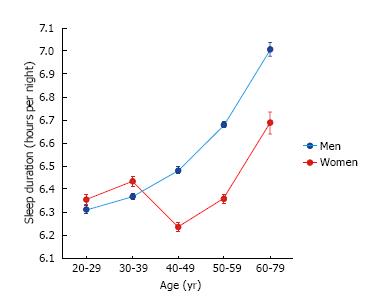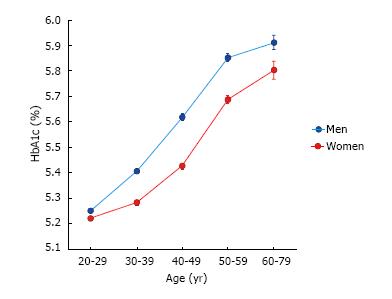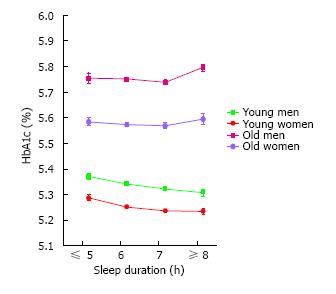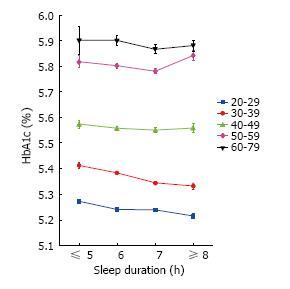Copyright
©The Author(s) 2017.
World J Diabetes. Aug 15, 2017; 8(8): 397-406
Published online Aug 15, 2017. doi: 10.4239/wjd.v8.i8.397
Published online Aug 15, 2017. doi: 10.4239/wjd.v8.i8.397
Figure 1 Sleep duration according to age groups and sex.
Each point and vertical bar represent the mean ± 1.96 SE. Sleep duration in men and women increased with increasing age (both P < 0.0001, ANOVA). Significant differences were observed in sleep duration between men and women in all age groups (all P < 0.0001, except for P = 0.003 in the 20s, t-test). The corresponding number of subjects is shown in the side of the bar.
Figure 2 HbA1c levels according to age groups divided by decades.
Each point and vertical bar represent the mean ± 1.96 SE. HbA1c levels in men and women increased with increasing age (both P < 0.0001, ANOVA). Significant differences were observed in HbA1c levels between men and women in all age groups (all P < 0.0001, t-test). The corresponding number of subjects is the same as that in Figure 1.
Figure 3 Relationship between HbA1c levels and sleep duration according to age and sex.
Each point and vertical bar represent the mean ± SE. P values for ANOVA were < 0.0001, 0.0001, 0.002, and 0.56 for young men, young women, older men, and older women, respectively. The corresponding number of subjects is shown in the side of the bar.
Figure 4 Relationship between HbA1c levels and sleep duration according to age groups divided by decades.
Each point and vertical bar represent the mean ± SE. Correlation coefficients and P values of Pearson’s correlation were r = -0.03, P < 0.0001 for the 20s, r = -0.05, P < 0.0001 for the 30s, r = -0.01, P = 0.41 for the 40s, r = 0.01, P = 0.52 for the 50s, and r = -0.01, P = 0.32 for the 60-70s, respectively. The corresponding number of subjects is shown in the side of the bar.
Figure 5 Relationship between sleep duration and impaired glucose metabolism, and plausible underlying mechanisms.
AEBAS: Abnormal eating behavior around sleep.
- Citation: Nakajima K, Suwa K, Toyama K. Age-dependent changes in the association between sleep duration and impaired glucose metabolism. World J Diabetes 2017; 8(8): 397-406
- URL: https://www.wjgnet.com/1948-9358/full/v8/i8/397.htm
- DOI: https://dx.doi.org/10.4239/wjd.v8.i8.397













